Page 4 of 5
Re: Joy Christian's Original 3-Sphere Model Updated
Posted: Tue Jan 18, 2022 3:09 pm
by FrediFizzx
jreed wrote: ↑Tue Jan 18, 2022 12:29 pm ...
Nice work Fred. You got rid of the dual detectors, and those missing samples. Now you have a perfect simulation that proves that the inner product of two quaternions is exactly equal to the cosine of the angle between them. You can easily see this by running your program with m = 10, for example. Each sample falls exactly on the cosine curve. There's no scatter in you model. m = 1000 is sufficient to duplicate the cosine curve. What this has to do with Bell escapes me. By the way, you can also get rid of lambda now. It has no effect on the output.
Come back when you understand the difference between the theoretical analytical product calculation and the calculation using the A and B +/-1 outcomes. Yep, you are still pretty pathetic at understanding EPR-Bell. It might be better for you to ask questions instead of making really dumb Bell fanatic comments.
.
Re: Joy Christian's Original 3-Sphere Model Updated
Posted: Tue Jan 18, 2022 3:21 pm
by Joy Christian
FrediFizzx wrote: ↑Tue Jan 18, 2022 2:57 pm
Joy Christian wrote: ↑Tue Jan 18, 2022 1:00 pm
Thanks again, Fred. I only plan to reference the simulation, not include it. So if you can make a separate thread for it and lock it, then that would be ideal.
Well, it will be a separate section like "Updated EPR Paper". What do you want to name it?
I have given the following name to the simulation for the purpose of referencing it in the paper: "Simulation of the 3-Sphere Model for the singlet correlations." You can give the same name to the section, or a shorter version of it.
.
Re: Joy Christian's Original 3-Sphere Model Updated
Posted: Tue Jan 18, 2022 3:55 pm
by FrediFizzx
Joy Christian wrote: ↑Tue Jan 18, 2022 3:21 pm
FrediFizzx wrote: ↑Tue Jan 18, 2022 2:57 pm
Joy Christian wrote: ↑Tue Jan 18, 2022 1:00 pm
Thanks again, Fred. I only plan to reference the simulation, not include it. So if you can make a separate thread for it and lock it, then that would be ideal.
Well, it will be a separate section like "Updated EPR Paper". What do you want to name it?
I have given the following name to the simulation for the purpose of referencing it in the paper: "Simulation of the 3-Sphere Model for the singlet correlations." You can give the same name to the section, or a shorter version of it.
OK, I actually didn't need to make a new forum section. I just made a new topic in the locked "Updated EPR Paper" section and put two posts in there for the two simulations. You can choose either one to reference to or to both by using this link,
viewtopic.php?t=34
.
Re: Joy Christian's Original 3-Sphere Model Updated
Posted: Wed Jan 19, 2022 3:38 pm
by FrediFizzx
Actually it doesn't matter which link you reference. They will see both versions anyways unless you just link to one of the PDF files.
.
Re: Joy Christian's Original 3-Sphere Model Updated
Posted: Fri Feb 18, 2022 7:04 pm
by FrediFizzx
Here is a version of Joy's original 3-sphere model modified for no orientation lambda. It is also a Bell junk physics theory killer.



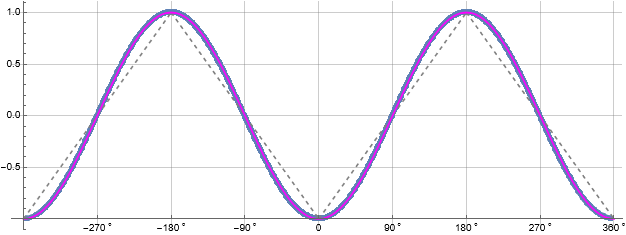
Cloud File.
https://www.wolframcloud.com/obj/fredif ... -forum1.nb
Direct Files.
sims/S3quat-3D2D-prodcalc-forum1.pdf
sims/S3quat-3D2D-prodcalc-forum1.nb
Enjoy! Hey John, no orientation lambda. What are you going to do now?

It's a Bell killer!
.
Re: Joy Christian's Original 3-Sphere Model Updated
Posted: Sun Feb 20, 2022 4:52 am
by FrediFizzx
This version is very simple to understand so, for the benefit of lurkers like Justo, we will do some further explanation of the code. First we have the singlet 3D unit vector "s" being randomly generated in an independent Do-loop. Then we use that to make Ls1 and Ls2 which are pure quaternions that represent the spin of the two particles that go to Alice and Bob,
Code: Select all
Ls1[[k]] = s . Qcoordinates; (*Convert to quaternion; A particle spin*)
Ls2[[k]] = -s . Qcoordinates, (*B particle spin plus conservation of angular momentum*)
Which typically look like this for the first iteration,
Code: Select all
In[662]:= Ls1[[1]]
Ls2[[1]]
Out[662]= Quaternion[0., -0.650358, 0.707279, 0.277111]
Out[663]= Quaternion[0., 0.650358, -0.707279, -0.277111]
Then we do the same thing for the "a" and "b" polarizer detection angles by converting them to x-y coordinates in a 3D setting,
Code: Select all
Da = aa . Qcoordinates; (*Convert to quaternion; A detector*)
And they typically look like this for the second iteration,
Code: Select all
In[666]:= Daa[[2]]
Dbb[[2]]
Out[666]= Quaternion[0., -0.207912, 0.978148, 0.]
Out[667]= Quaternion[0., -0.857167, 0.515038, 0.]
Pure quaternions with the "z" or "K" component set to zero. Then we have the interaction between the two particle spins and the detectors which look like this for the second iteration,
Code: Select all
In[668]:= Daa[[2]] ** Ls1[[2]]
Ls2[[2]] ** Dbb[[2]]
Out[668]= Quaternion[0.533731, 0.783663, 0.166573, 0.270661]
Out[669]= Quaternion[-0.166055, 0.412633, 0.686737, 0.574937]
We then have the product calculation with the limits imposed which typically looks like,
Code: Select all
In[670]:= pc = Limit[Daa[[2]] ** Ls1[[2]] ** Ls2[[2]] ** Dbb[[2]], {Ls1[[2]] -> Sign[aa1[[2]] . s1[[2]]] Daa[[2]],
Ls2[[2]] -> Sign[bb1[[2]] . s1[[2]]] Dbb[[2]]}]
Out[670]= Quaternion[-0.681998, 4.18649*10^-18, 3.39127*10^-17, 0.731354]
And then we can see that the real part of that quaternion is equal to
-a.b for the second iteration again,
Code: Select all
In[671]:= -aa1[[2]].bb1[[2]]
Out[671]= -0.681998
So over many iterations, the imaginary components cancel each other in the same way as the A and B outcomes individually vanish and we have for the mean,
Code: Select all
Imaginary part vanishes. meanpc = (0.00788064 +8.69336*10^-21 I)-1.62212*10^-19 J+0.00311446 K
That is all there is do it other than showing the A and B outcome averages.
.
Re: Joy Christian's Original 3-Sphere Model Updated
Posted: Mon Feb 21, 2022 12:10 am
by gill1109
So when’s the paper coming out?
Re: Joy Christian's Original 3-Sphere Model Updated
Posted: Mon Feb 21, 2022 12:39 am
by FrediFizzx
gill1109 wrote: ↑Mon Feb 21, 2022 12:10 am
So when’s the paper coming out?
Last week.
.
Re: Joy Christian's Original 3-Sphere Model Updated
Posted: Mon Feb 21, 2022 6:16 am
by FrediFizzx

Some might take that to be a continuous curve but it is not. Drop the iterations down to 200,
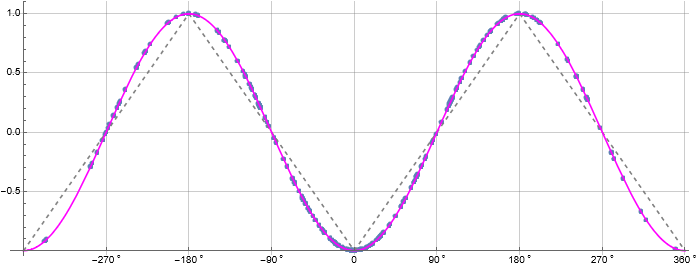
then you can see the spaces between the data points. The QM prediction of
-a.b is the same way.
.
Re: Joy Christian's Original 3-Sphere Model Updated
Posted: Mon Feb 21, 2022 7:30 am
by jreed
So you discovered that you don't need many samples to generate your cosine curve. Just a few will do fine, like I said before. The inner product of two quaternions is equal to the cosine of the angle between them. What difference does it make if the cross product isn't zero? It isn't used in your calculation for anything. Your program could be greatly simplified: Just concentrate on the inner product, or just calculate the cosine of the angle between the vectors. You don't need quaternions to do that. By the way, thanks for taking my name off the credits in your program.
Re: Joy Christian's Original 3-Sphere Model Updated
Posted: Mon Feb 21, 2022 7:42 am
by FrediFizzx
jreed wrote: ↑Mon Feb 21, 2022 7:30 am
So you discovered that you don't need many samples to generate your cosine curve. Just a few will do fine, like I said before. The inner product of two quaternions is equal to the cosine of the angle between them. What difference does it make if the cross product isn't zero? It isn't used in your calculation for anything. Your program could be greatly simplified: Just concentrate on the inner product, or just calculate the cosine of the angle between the vectors. You don't need quaternions to do that. By the way, thanks for taking my name off the credits in your program.
Poor John; still doesn't understand the physics of what is happening with the spins of the particle pair from the singlet. As I said before -- very pathetic. Probably because he left them out on his first quaternion version of this. Now..., he wants me to leave them out. Yes, very pathetic. My demonstration is too simple to not understand it. Well, of course if John claims to understand it then he is admitting that Bell's theory is junk physics.



Re: Joy Christian's Original 3-Sphere Model Updated
Posted: Mon Feb 21, 2022 8:35 am
by FrediFizzx
FrediFizzx wrote: ↑Mon Feb 21, 2022 7:42 am
jreed wrote: ↑Mon Feb 21, 2022 7:30 am
So you discovered that you don't need many samples to generate your cosine curve. Just a few will do fine, like I said before. The inner product of two quaternions is equal to the cosine of the angle between them. What difference does it make if the cross product isn't zero? It isn't used in your calculation for anything. Your program could be greatly simplified: Just concentrate on the inner product, or just calculate the cosine of the angle between the vectors. You don't need quaternions to do that. By the way, thanks for taking my name off the credits in your program.
Poor John; still doesn't understand the physics of what is happening with the spins of the particle pair from the singlet. As I said before -- very pathetic. Probably because he left them out on his first quaternion version of this. Now..., he wants me to leave them out. Yes, very pathetic. My demonstration is too simple to not understand it. Well, of course if John claims to understand it then he is admitting that Bell's theory is junk physics.
I'll explain this a little more so perhaps some lurkers will understand how easy it is to destroy Bell's junk physics theory. Of course, at least the vectors of the singlet pair must be involved but if you do the product calculation with just the vectors, you end up with
-(a.s)(s.b) which is not, nor ever will be
-a.b. To properly represent the spins of the particles going to A and B, you have to use quaternions, or bivectors, or Pauli matrices. There is no way of getting around that simple fact contrary to what John might have you believe. Here is what is happening in the quaternion product calculation for the second iteration.
Code: Select all
In[230]:= Ls1[[2]] ** Ls2[[2]]
Daa[[2]] ** Quaternion[1., 0., 0., 0.] ** Dbb[[2]]
-aa1[[2]].bb1[[2]]
Out[230]= Quaternion[1., 0., 0., 0.]
Out[231]= Quaternion[0.970296, 0., 0., -0.241922]
Out[232]= 0.970296
The real part matches
-a.b but there is an imaginary part, -0.241922K, that cancels out over many iterations. And we see that the product calculation of the two particle spins is 1 always.
.
Re: Joy Christian's Original 3-Sphere Model Updated
Posted: Tue Feb 22, 2022 10:47 pm
by gill1109
FrediFizzx wrote: ↑Mon Feb 21, 2022 12:39 am
gill1109 wrote: ↑Mon Feb 21, 2022 12:10 am
So when’s the paper coming out?
Last week.
Ah, it would have been all over social media, but first, there was that storm, and after that everyone was watching Putin. That's sad.
Re: Joy Christian's Original 3-Sphere Model Updated
Posted: Wed Feb 23, 2022 4:41 am
by FrediFizzx
In Joy's updated 3-Sphere model we have,
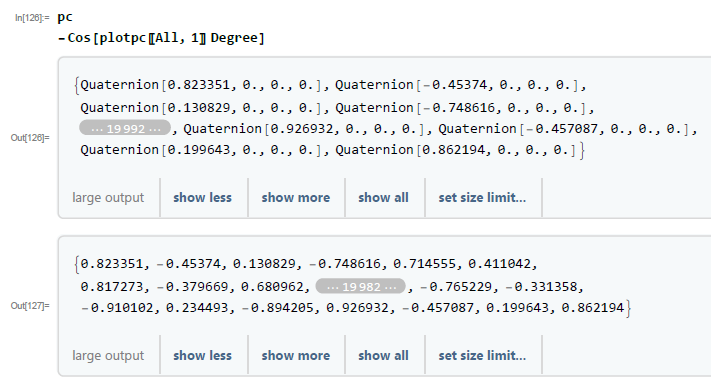
For every iteration the imaginary part is zeroed out and we can see that the real part is equal to
-a.b.
.
Re: Joy Christian's Original 3-Sphere Model Updated
Posted: Fri Feb 25, 2022 8:22 pm
by gill1109
Yeah, Mathematica has the cosine and knows how to multiply quaternions.
Re: Joy Christian's Original 3-Sphere Model Updated
Posted: Sat Feb 26, 2022 6:27 am
by FrediFizzx
FrediFizzx wrote: ↑Wed Feb 23, 2022 4:41 am
In Joy's updated 3-Sphere model we have,

For every iteration the imaginary part is zeroed out and we can see that the real part is equal to
-a.b.
I suppose we should do some further explanation of the above. You will need to refer to the simulation here.
sims/newCS-52-S3quat-3D-new-prodcalc-joy.pdf
Basically the numerator of r0 is all cross products so when you take the limits you get {0, 0, 0} for r0 for every iteration. Which is good. In the original 3-sphere model product calculation the limits just drop out and are never taken. Quite clever on Joy's part to figure this out. I could post some of the analytical math if further explanation is asked for.
.
Re: Joy Christian's Original 3-Sphere Model Updated
Posted: Sat Feb 26, 2022 7:16 am
by Joy Christian
.
Gill does not want to understand anything. If he wanted to, then he would have done so 15 years ago. All of his excuses for not accepting the truth are now destroyed. What you have explained above, Fred, destroys his last quibble about the orientation lambda, which is no longer used in the above simulation.
.
Re: Joy Christian's Original 3-Sphere Model Updated
Posted: Sat Feb 26, 2022 7:58 am
by FrediFizzx
Joy Christian wrote: ↑Sat Feb 26, 2022 7:16 am
.
Gill does not want to understand anything. If he wanted to, then he would have done so 15 years ago. All of his excuses for not accepting the truth are now destroyed. What you have explained above, Fred, destroys his last quibble about the orientation lambda, which is no longer used in the above simulation.
Sure, we have known for years that Bell fanatics don't want to understand that you have destroyed Bell's junk physics theory a long time ago. Now they have no excuses... yet. However, the simulation of the updated 3-sphere model product calculation verification of the prediction of
-a.b is a bit difficult to understand without the analytical math. So, for the benefit of lurkers, etc. here it is.
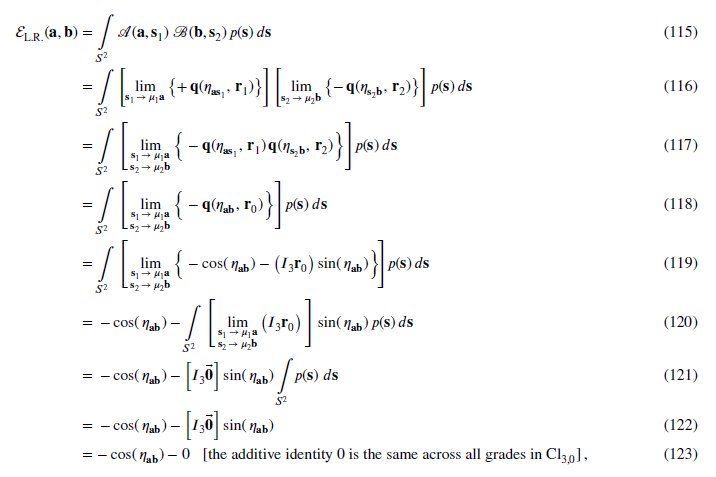
And we would be happy to answer any no-nonsense questions.
.
Re: Joy Christian's Original 3-Sphere Model Updated
Posted: Sat Feb 26, 2022 7:28 pm
by FrediFizzx
FrediFizzx wrote: ↑Sat Feb 26, 2022 7:58 am
Joy Christian wrote: ↑Sat Feb 26, 2022 7:16 am
Gill does not want to understand anything. If he wanted to, then he would have done so 15 years ago. All of his excuses for not accepting the truth are now destroyed. What you have explained above, Fred, destroys his last quibble about the orientation lambda, which is no longer used in the above simulation.
Sure, we have known for years that Bell fanatics don't want to understand that you have destroyed Bell's junk physics theory a long time ago. Now they have no excuses... yet. However, the simulation of the updated 3-sphere model product calculation verification of the prediction of
-a.b is a bit difficult to understand without the analytical math. So, for the benefit of lurkers, etc. here it is.

And we would be happy to answer any no-nonsense questions.
One clarification; In the simulation, s = s1 = -s2 and for the analytical calculation, s = s1 = s2. Just a matter of where you put the minus signs.
An obvious question would be -- how do you get from eq. (117) to eq. (118)? Well, the proof of that is quite lengthy but if anyone is interested we can get into it.
.
Re: Joy Christian's Original 3-Sphere Model Updated
Posted: Mon Feb 28, 2022 3:50 am
by FrediFizzx
Here is an improved simplified version of the updated 3-Sphere model Mathematica code.
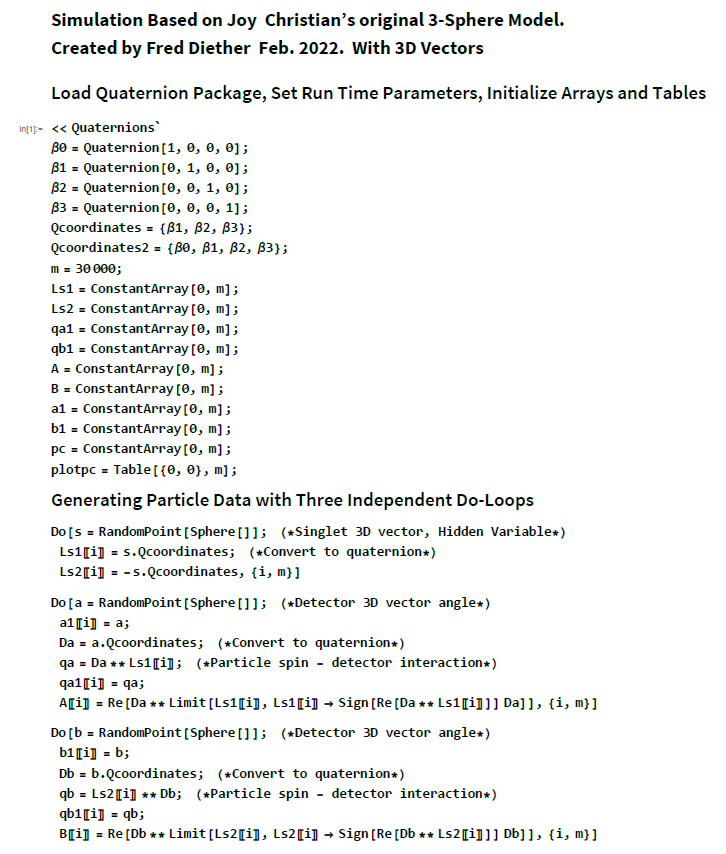
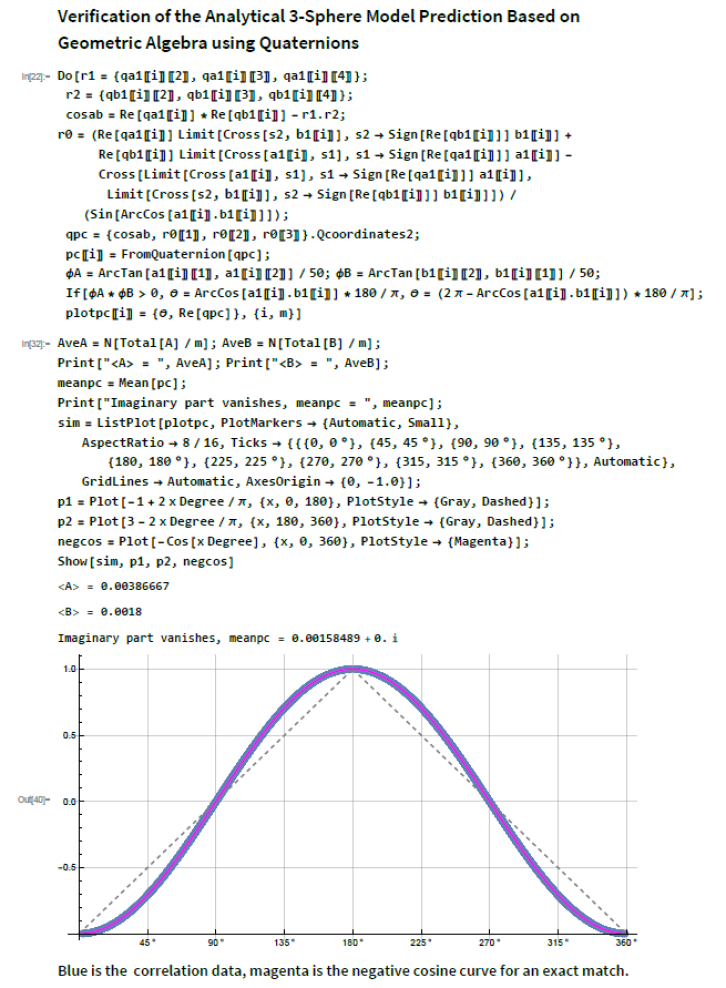
It predicts
-a.b exactly! Same as quantum mechanics. The Bell fanatics are finished.
.





